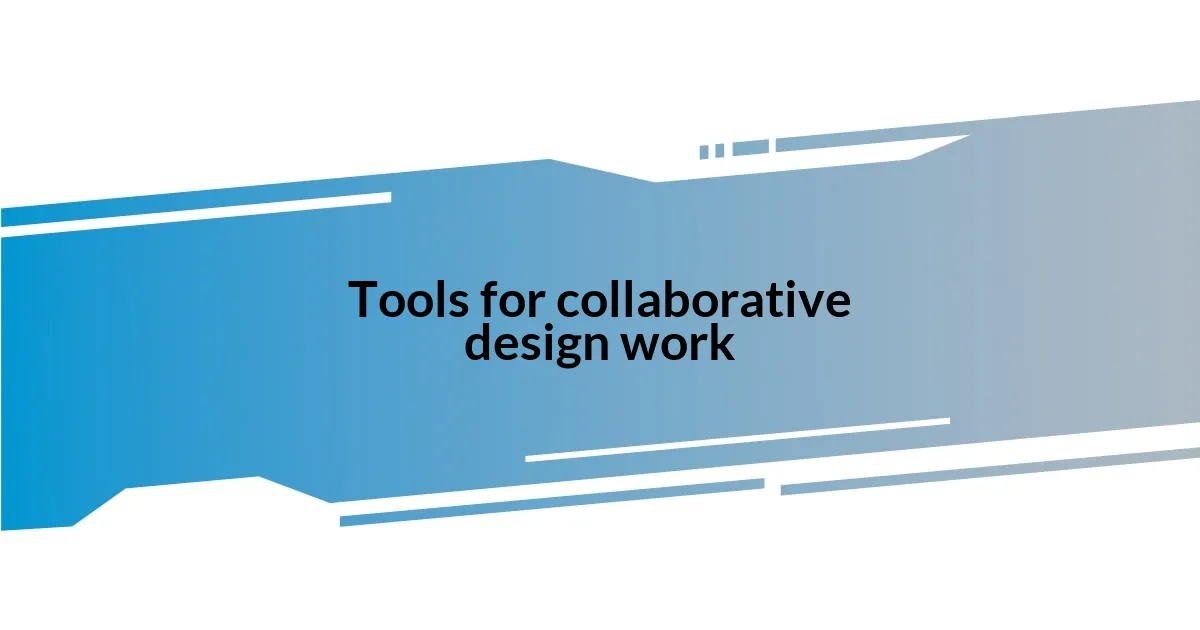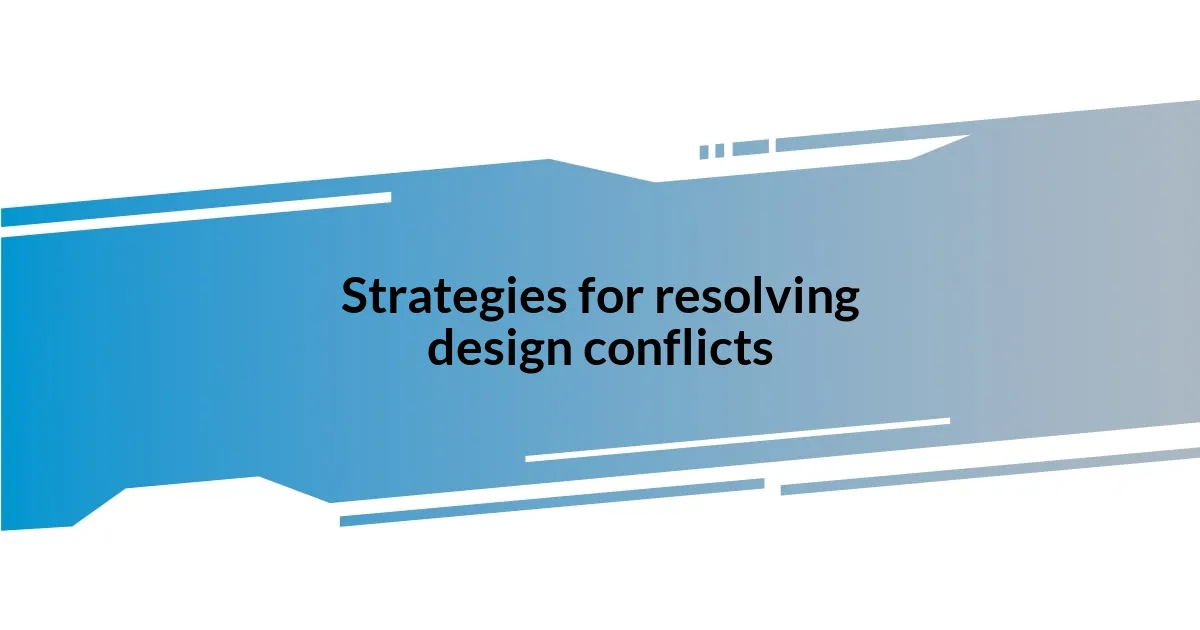Key takeaways:
- Effective design collaboration relies on trust, open communication, and valuing all team members’ input to foster creativity and innovation.
- Implementing strategies like active listening, using visual aids, and establishing feedback loops enhances communication and team dynamics.
- Regularly measuring success through KPIs and emotional resonance of collaboration helps teams reflect on their processes and improve continuously.

Understanding design collaboration
Design collaboration is like a lively dance where each partner brings their unique strengths to create a harmonious performance. I remember a project where our team melded educators and designers together, and it felt like we were all speaking different languages at first. Have you ever experienced that exhilarating moment when the pieces finally come together, turning chaos into something beautiful?
At its core, effective design collaboration thrives on open communication and trust. I’ve seen firsthand how a simple conversation can transform tension into synergy. It’s that moment when someone shares a bold idea, and instead of shutting it down, the team rallies around it, sparking creativity. Doesn’t it feel great to know that collaboration can lead to innovative solutions that none of us could have envisioned alone?
Furthermore, understanding design collaboration means embracing vulnerability. Sharing your creative thoughts can be intimidating, yet it’s often in those moments of discomfort where the most meaningful discussions happen. I vividly recall a particularly challenging brainstorming session where we all laid our ideas bare; it opened the floodgates to incredible outcomes. How do you feel about stepping out of your comfort zone in collaborative settings?

Key principles of design teamwork
Design teamwork hinges on a few key principles that can elevate the entire process. Trust is paramount; I’ve found that when team members genuinely believe in each other’s capabilities, they’re more willing to push boundaries. I once worked on a project where, instead of assigning roles rigidly, we allowed each person’s strengths to emerge naturally. It felt freeing and ultimately led to an outstanding result that we were all proud of.
Another critical principle is clear and consistent communication. I recall a project where we faced unexpected hurdles because assumptions went unspoken. Once we established a routine of catch-up meetings, it was like flipping a switch. Suddenly, ideas flowed more freely, and we could tackle issues as a united front. Have you experienced a similar transformation when communication improved within your team?
Lastly, establishing an inclusive environment where everyone’s input is valued can create rich discussions. I remember a time when a junior designer timidly suggested an idea that we initially overlooked. However, when we revisited it, it led to a breakthrough in our project. This taught me that embracing every voice can yield unexpected and innovative outcomes that might otherwise go unnoticed.
| Key Principle | Description |
|---|---|
| Trust | Team members believe in each other’s capabilities, fostering creativity. |
| Communication | Clear dialogue helps address issues promptly and encourages idea sharing. |
| Inclusivity | Valuing every voice enhances discussions and yields innovative outcomes. |

Effective communication in design
Effective communication in design is a dance where every step counts. I remember one project where I initially struggled to articulate my vision for a user interface. It was a roundtable discussion with team members, and I felt vulnerable sharing. Yet, once I voiced my thoughts, everyone chimed in with their perspectives. This back-and-forth dialogue not only clarified my ideas but also sparked new ones that I hadn’t considered. It reminded me how vital it is to create an environment where everyone feels empowered to share, because that’s where magic can happen.
To enhance communication in design, consider these essential strategies:
- Active Listening: Make it a habit to truly hear what others are saying. I once noticed that just nodding along didn’t suffice; asking clarifying questions made my teammates feel valued and encouraged deeper exploration of ideas.
- Visual Aids: Sometimes words fall short. I experienced a breakthrough when I started using sketches and diagrams to demonstrate concepts. It helped to align the team’s vision quickly.
- Feedback Loops: Establish a culture where feedback is constructive and continuous. I learned that regular check-ins reduce misunderstandings and enhance collaborative development.
- Common Language: Try to define terms or jargon at the beginning of a project. In a UX project, we spent a few minutes laying out our terminology, which made all the difference in our discussions moving forward.
With these strategies, I’ve seen firsthand how effective communication fosters a vibrant, creative atmosphere.

Tools for collaborative design work
Exploring the right tools for collaborative design work can truly transform how a team interacts. One of my favorite tools is Figma. I remember a time when our remote team tackled a tight deadline. Figma’s real-time editing feature was a game-changer. It felt exhilarating to see my teammates adjust designs simultaneously, like we were working side-by-side, even though we were miles apart.
Another tool that stands out for me is Miro. During a brainstorming session, I loved how we could sketch out ideas visually and move sticky notes around together. It felt like we were all contributing to one canvas, creating momentum that fueled our discussion. Have you ever felt that thrill when collaboration comes together so seamlessly? It’s that kind of engaging experience that keeps me coming back to Miro.
I also find project management tools, like Trello or Asana, invaluable. These platforms help us track tasks and deadlines, keeping everyone aligned. I vividly recall a project where we had several moving parts. Using Trello made it easy to visualize progress and make adjustments on the fly. It’s satisfying to clear tasks off the board, right? Those small wins help maintain motivation and focus, creating a sense of accomplishment within the team.

Strategies for resolving design conflicts
One effective strategy I’ve found for resolving design conflicts is to embrace a structured brainstorming session. I remember a time when two designers were at odds over typography choices. Instead of letting the tension simmer, we gathered for a focused session where each person explained their rationale. This approach not only diffused the conflict but also led to a hybrid solution that incorporated elements from both ideas. Have you ever witnessed how a simple conversation can turn adversity into collaboration?
Another method that resonates with my experience is the use of “design crits,” where team members present their work to the group for constructive feedback. Once, during a crit, I was hesitant to share a project I was proud of, fearing critique. But when I did, the feedback wasn’t just about flaws; it sparked a rich discussion that brought my design to an entirely new level. I learned that these sessions, when done right, create a safe space for vulnerability and growth—kind of like designing together, where the outcomes surpass our individual contributions.
Lastly, I’ve found that creating a shared goals document can be invaluable in aligning the team. In a past project, we drafted a simple one-pager that outlined our collective vision and objectives. This clarity made it easier to navigate disagreements, as we could always circle back to our shared purpose. Have you tried this approach? It’s amazing how grounding in common objectives can act like a compass, steering the team through conflicts and keeping us focused on what truly matters.

Fostering creativity in design teams
Fostering creativity in design teams is about creating an environment that encourages exploration. I recall a project where we held weekly creative sessions strictly meant for idea generation, free from the constraints of deadlines. This openness led to some of the most innovative concepts; it’s incredible how stepping away from routine tasks can breathe new life into our thinking. Have you ever noticed how those “no-pressure” moments spark your best ideas?
Collaboration also thrives on diversity of thought. I remember working with a team that included members from various backgrounds. Each person’s unique perspective contributed to brainstorming sessions that felt electric. I often find myself thinking: how can a fresh set of eyes shift our approach? When different viewpoints come together, creativity flourishes as we build upon one another’s ideas, making the final output richer.
Lastly, I believe in the power of play. One time, we incorporated playful activities, like design games, into our workflow. This light-hearted approach not only loosened our minds but also built strong camaraderie amongst the team. It’s fascinating how laughter and creativity go hand in hand—do you feel that way too? When we foster an environment where play is welcome, it ignites a spark that leads to imaginative solutions.

Measuring success in design collaboration
Measuring success in design collaboration often hinges on clear outcomes. I once worked on a project where we set specific key performance indicators (KPIs) to assess our collaboration. These included not just the finished product quality, but also team engagement and creativity levels. It surprised me how mapping out these metrics helped us reflect on our process mid-way, allowing us to pivot and improve continuously.
Feedback loops have proven vital in my experience as well. After completing a project, we gathered to discuss what worked and what didn’t. I still remember the heartfelt moments when team members shared how collaborative efforts made them feel included and valued. Have you ever evaluated a project not just on its results, but on the growth and satisfaction of the team? This deeper reflection can uncover nuances that traditional metrics might miss.
Moreover, I find that the emotional resonance of collaboration can be a great indicator of success. I recall a team that truly celebrated each other’s contributions, leading to an atmosphere ripe for innovation. The energy was palpable during our discussions, and even the challenges felt manageable. Isn’t it fascinating how a shared sense of accomplishment can elevate the entire team’s morale? Fostering this emotional connection can often lead to extraordinary creativity and commitment in the design process.